This post may contain affiliate links. Please read our disclosure policy. As an Amazon Associate, I earn from qualifying purchases.
This whole grain gluten free flour blend brings a rich flavor and texture to your baked goods. No rice flour here, just the goodness of ancient grains like millet, teff, and amaranth. This homemade gluten free flour mix is balanced for consistent texture and it will store well for months.
Best of all, it’s a cup-for-cup substitute for all-purpose or whole wheat flour, so it’s a simple swap in your favorite recipes. Plus, it’s free from common allergens…. no corn, peanuts, tree nuts, rice, or dairy.
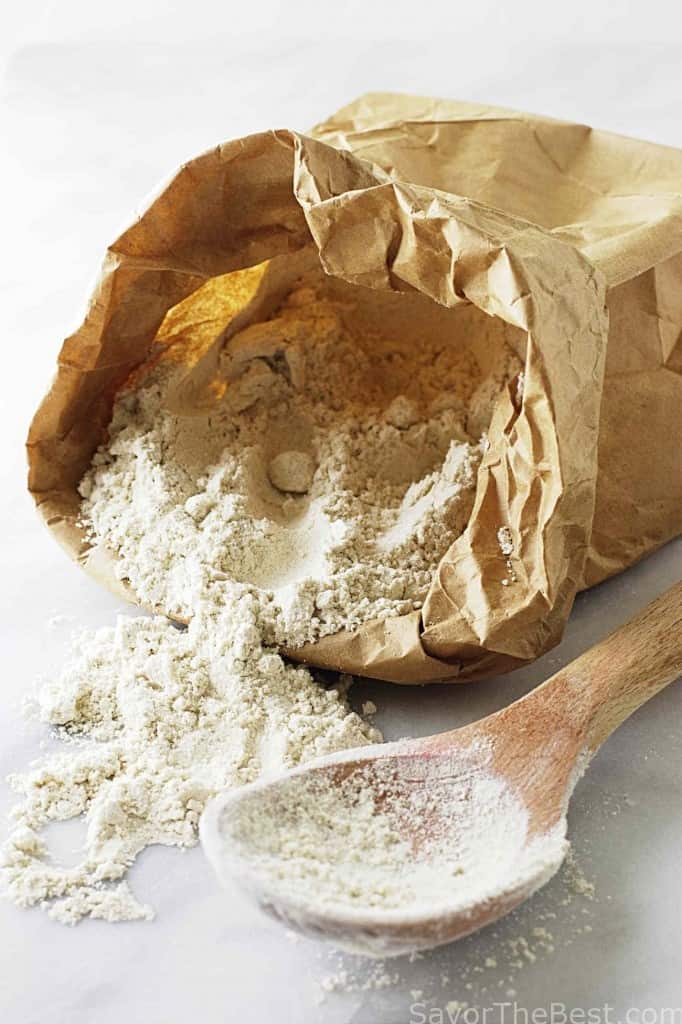
Inspired by King Arthur’s ancient grains blend, this recipe was customized through extensive testing for a high-performing, all-purpose gluten-free flour substitute.
Here is Why This Whole Grain Gluten Free Flour Recipe Works
No Rice Flour: Say goodbye to the same-old rice-based blends! This mix uses ancient grains for a deeper flavor and texture.
Stores Like a Champ: Make it once, bake for months. This blend stays fresh in the fridge or freezer, so you’re always ready to bake on a whim.
Balanced for Great Results: The combo of whole grains and starches is just right for texture—no chalky bakes here.
Perfectly Measured: Weigh it or spoon it, this mix is ready to go either way, with conversions that make sense for every baker.
The Ingredients
- Pantry Flours: Millet flour, tapioca flour, arrowroot flour, teff flour, sorghum flour, amaranth flour
- Specialty Items: Xanthan gum (for binding, moisture retention, and elasticity)
Each ancient grain brings something unique: millet adds a soft texture, teff provides structure and moisture retention, and sorghum flour gives a light crumb. The starches, like tapioca and arrowroot, add lift and keep things light.
If you prefer a xanthan gum substitute, you can use psyllium husk powder or glucomanna, just triple the amount. However, note that without xanthan, baked goods might dry out a little faster and they will be a little more dense.
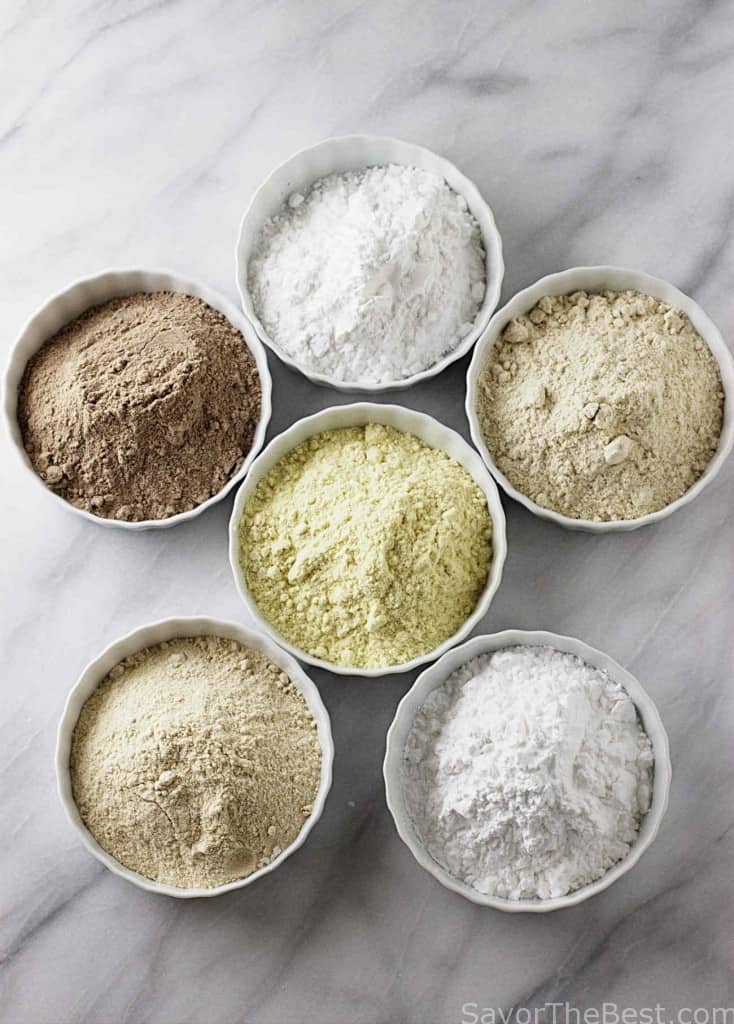
Tips for Success
- For the most accurate results, use a kitchen scale. Gluten-free flours can vary in density, so weighing ensures consistent results.
- If you’re using measuring cups instead of a scale, lightly spoon the flour into the cups and level off. Avoid packing it down, which can lead to dense results.
- Sifting or whisking the flours together helps prevent clumping and ensures an even texture in your baked goods.
- A little xanthan gum goes a long way! It adds elasticity and helps trap air for a light, fluffy texture, but too much can make your baked goods dense or even gummy.
Storage
Room Temperature: Store the flour blend in an airtight container in a cool, dry place for up to 1 month.
Refrigerator: For longer storage, keep the blend in the fridge for up to 3 months. Be sure to keep it sealed to prevent moisture from getting in.
Freezer: To extend the shelf life even more, freeze the gluten-free flour blend for up to 6 months. Use a freezer-safe, airtight container or bag. Let it come to room temperature before using, as any condensation from freezing can affect measurements and texture.
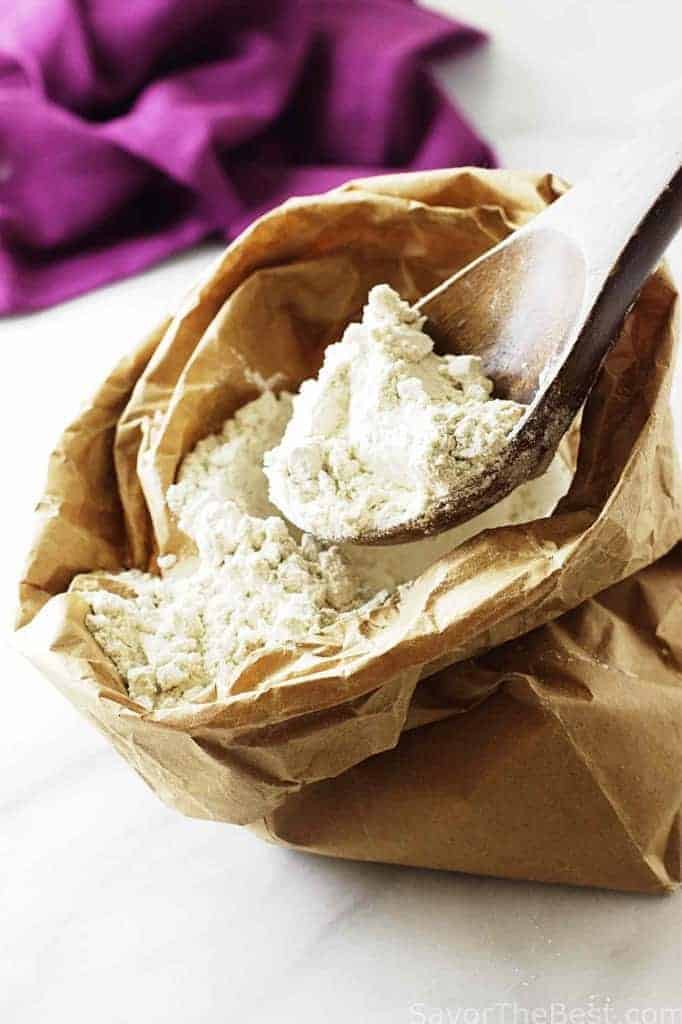
Gluten Free Flour Without Rice Flour
This gluten-free flour blend is all about flavor, versatility, and the kind of texture that doesn’t make you miss traditional flour one bit.
The ancient grains bring a bit of personality to every bake, without relying on rice flour! Plus, having this blend on hand means you’re ready to whip up baked goods whenever the mood strikes. We’d love to know what you create with it, so feel free to tag us and share your results!
Pin this now to find it later!
Pin It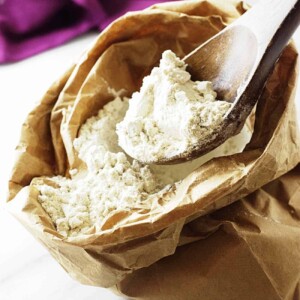
Ancient Grains Gluten Free Flour Blend
If you make this recipe, please leave a star rating and comment.
Equipment
Ingredients
- 325 grams millet flour, 2-½ cups plus 3 tablespoons
- 220 grams tapioca flour, 1-¾ plus 1 tablespoon
- 180 grams arrowroot flour, 1-½ cups plus 2 tablespoons
- 120 grams teff flour, ¾ cup
- 100 grams sorghum flour, ¾ cup
- 55 grams amaranth flour, ½ cup
- 2 ½ teaspoons xanthan gum
Instructions
- Whisk or sift all of the ingredients until well combined.
- Store in an airtight container in a cool dry place for 1 month, in the fridge for 3 months or the freezer for 6 months.
Notes
- This mix makes 8-1/3 cups of flour.
- 1 cup is equivalent to 120 grams.
- Baked goods made with this flour blend will freeze well.
- It is best to weigh your ingredients but if you don’t have a scale, lightly spoon the flours into your measuring cups.
Nutrition
Nutrition information is automatically calculated, so should only be used as an approximation.
 Like this recipe? Rate & comment below!
Like this recipe? Rate & comment below!

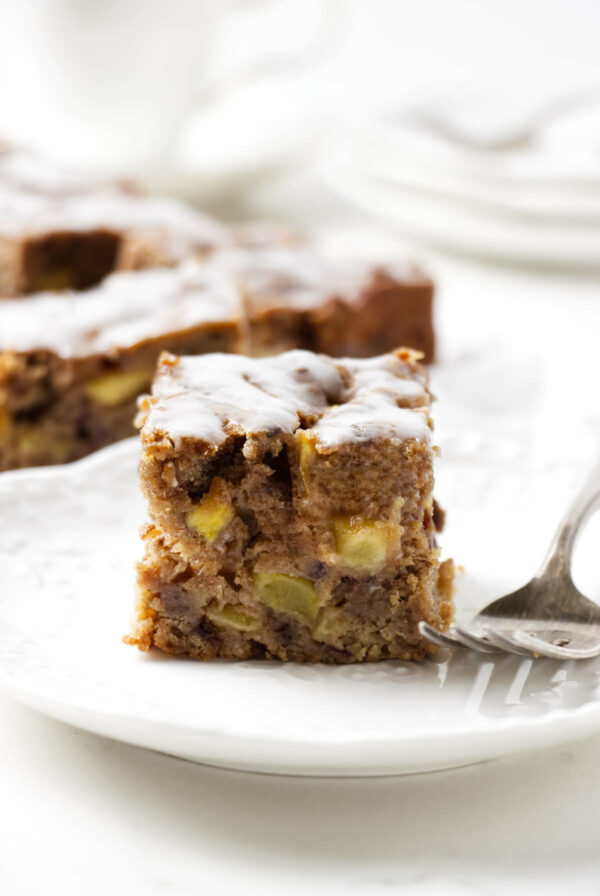
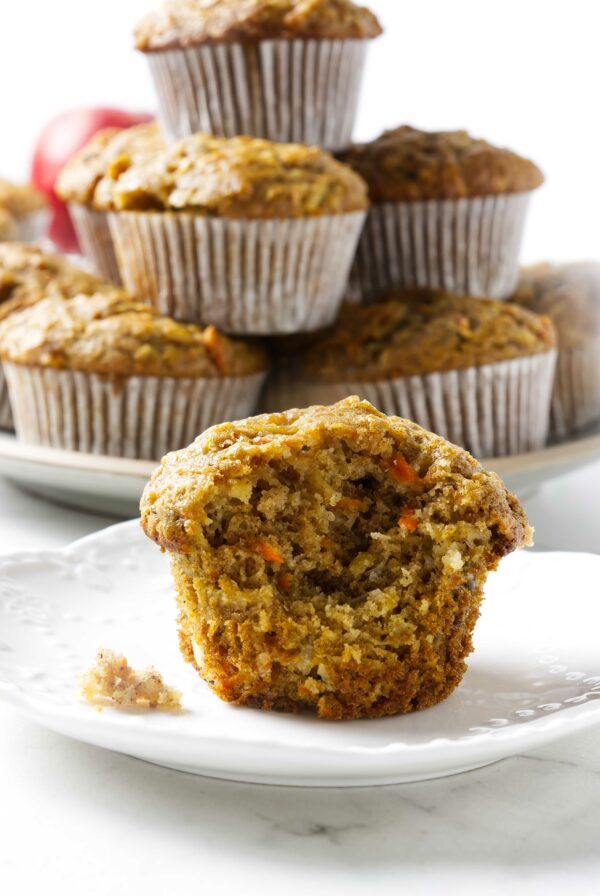
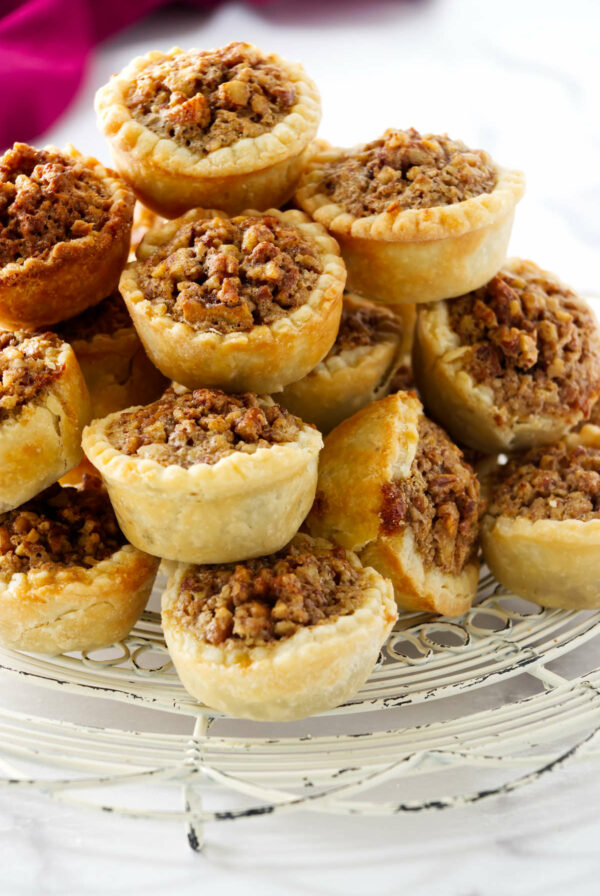
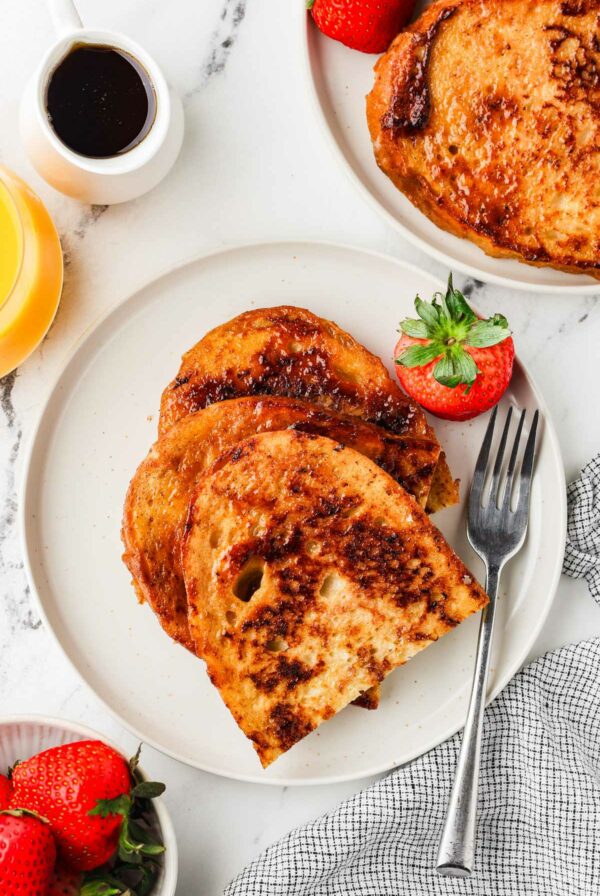










Hello! I’m sensitive to amaranth, do you think subbing quinoa flour for amaranth would be ok?
I haven’t tried it with quinoa flour but you could omit the amaranth flour and just replace it with extra millet flour.
Hi,
Thank you for creating such an amazing blend!
I have so many allergies, so I was overjoyed when I found this 🙂
I was wondering, if you could use this blend to substitute bread flour in recipes?
Look forward to hearing from you, and thank you 🙂
Margo
I have not tried this myself for yeast bread yet, but I have received feedback from readers that the following recipe works with this flour blend.
https://www.kingarthurbaking.com/recipes/gluten-free-sandwich-bread-recipe
If you are looking for a yeast-free bread then this flour works with any recipe that uses baking soda and/or baking powder as a leavening. I just substitute this flour 1:1 for the flour called for in the original recipes.
Can’t wait to try this. By chance have you used this to make pasta? I’m curious and may have to give it a try.
I haven’t made pasta with this blend yet. I wish I could tell you how it turns out but I’m not sure how it will hold up during the boiling stage. I suspect it will work as long as you make a firm dough
I would think that you would need more xanthan gum in order to make a pasta dough that will not come apart in the boiling stage….
You may be right, I haven’t tried it yet. It is on my LOOOONG list of to-do tasks 😉
Hi Pat and Dahn, thanks for this great recipe. Do you think I can substitute quinoa flour for the teff? Absolutely no chance that I could get teff here in India, especially not post-lockdown.
I haven’t tried replacing the teff with quinoa flour but it does work to eliminate the teff flour and increase the millet by 120 grams
Hi ?
I have Coeliac Disease, and I’m also allergic to dairy, eggs, soya, oats, almonds, potatoes and rice, and yeast is also not something that agrees with me.
So least to say, I almost fell off my chair when I found this recipe that’s free of everything I’m allergic to! ? I have been free from for just over 5 years now, and in that time I’ve had many cooking and baking disasters (most recently my 18th birthday cake, which the fire pit ended up eating ??) and I’d almost given up hope of ever making something that tasted nice again, till I this flour blend today ?
I was wondering, would different brands of the same flours give the same results? (As Bob’s Red Mill sorghum is a ‘may contain’ soya), And also, would there be a way to use this blend to substitute self-raising flour in recipes as well?
Thank you so, so much for creating a flour blend that’s not only does the job, but is also good for you- I know I will use this in everything I make! ? This is going to make my life so much easier ?
Thank you for reading my comment, and I look forward to hearing from you! ?
Jayla
Hi Jayla, it shouldn’t make a big difference if you use different brands. The commercially ground flour brands are generally ground to the same degree. The biggest difference would be if you tried to grind your own flours from the grains. If you want to create a self rising flour blend with this recipe then add 1-1/2 teaspoons of baking powder and 1/4 teaspoon of salt to every cup of flour… that will give you the equivalent of a self-rising flour
I am so thankful for this recipe. It has been a Godsend for my 15 year old who is recently gluten, dairy, almond, rice, and oat free. Replacing baked goods has been a huge challenge for us since so many gf blends contain one of those. Everything we have tried has come out beautifully, and its greatly expanded our breakfast options. The other day I made pancakes, and my son gave me the best compliment. “Mom, these taste like REAL pancakes!” ? Thank you for taking the time to figure out something that wasn’t a necessity for you so others could benefit.
Valerie, thank you so much for this comment. I am delighted to hear how helpful it has been and so thrilled that your son can have pancakes and other baked goods. If you haven’t already found this site for My Allergy Advocate, you may want to take a look. She might also have some helpful resources and recipes for all the dietary restrictions.
I used this flour to make a suggested yeast bread from King Arthur flour. I decreased the cornstarch and tapioca starch 30 gm each and added 1/2 cup oat fiber from honeyville to increase the fiber. Used more millet flour to replace amaranth flour and added 1 tsp dough enhancer. Made as directed with one rise in the pan per recommendations of this site. The bread came out awesome. It rose well and has good texture. Next time I will try making rolls. Thank you so much. Teri 🙂
That is fantastic Teri! Thanks for updating us, I love hearing how people are using this flour and your modifications sound great!
You are welcome. Thanks for the flour blend recipe.
?
Teri, does that mean you added the extra Xanthan Gum called for in the King Arthur bread recipe? And do you think psyllium husk would be ok in place of the oat fiber as long as something is added to absorb/retain more moisture? This is new to me so apologies for all the questions, but will the dough enhancer really make much difference because the ingredients in the one I’m looking at is tapioca flour, sunflower lecithin, ascorbic acid and ginger root and tapioca flour is already in the flour.
I don’t know if Patricia will weigh in here but I will give you my thoughts. If you are using a flour blend that already has Xanthan gum then you shouldn’t have to add much or any additional Xanthan gum to the recipe. Keep in mind that too much Xanthan gum will ruin the texture of your bread. Psyllium husk will help act as a binder as well but too much can also destroy the texture of your bread. If you are using this particular flour blend, you shouldn’t need to add the psyllium husk or dough enhancer.
Awesome! Thank you Dahn
your welome
I was after a gluten free, potato flake sourdough bread recipe. I used this combination of flour minus the Xanthan Gum. I used 2-1/2 cups of the flour in place of the food in this recipe and beat for around 3 minutes and only let it rise once and it was phenomenal. Thank you so much for sharing your flour recipe, it is exactly what I was after.
https://kaitnolan.com/2012/01/06/gluten-free-friday-sourdough-bread/
I asked this question a little while ago, but have another one: When you used this blend in the King Arthur bread recipe, did you leave out the extra xanthan gum called for in that recipe?
That recipe calls for letting the bread rise twice. To you do that or only once? Thank you, Teri
Hi Teri, Since this blend has xanthan gum in it then you shouldn’t need to add extra xanthan in recipes. However, If you do not add the xanthan gum to the flour blend then add it to the individual recipes. I do not typically let my gluten-free bread dough rise twice. Since there isn’t any gluten in this flour there really isn’t a reason to let it rise twice. The second rise is great for bread that has gluten in it because it helps the gluten develop more and achieve a finer crumb. Since you don’t have any gluten to develop then you can skip the second rise and save a bunch of time. 🙂
Thank you for responding so quickly. I will let you know how it comes out. Thx
You’re welcome! I can’t wait to hear 🙂
@Dahn Boquist, I am trying to use ground chia seed instead of the xanthan gum. We are making a loaf of sourdough with it. Fingers crossed
I hope that works, I have not tried it
@Dahn Boquist, It didn’t work. The loaf didn’t rise at all with the sourdough starter. Any thoughts?
I suspect the chia seeds do not offer enough structural support. If you can’t have xantham gum then you may want to try using psyllium husk and a bit of extra tapioca flour in the recipe. I’m also wondering if your sourdough starter is mature??
What can I use instead of amaranth flour please?
you can leave the amaranth flour out and increase the millet flour by 55 grams
Hello! Thank you for this delicious blend. I’ve used it twice now. I just want to be clear that it is a one for one equivalent for a recipe for gluten free flour only? Or can this flour replace any recipe one for one.. I’m just a little confused as to how I can use this for all myGF baking.
It is a one to one replacement for all-purpose flour unless the recipe calls for yeast. Yeast recipes need a little more help but other recipes work great with this blend. So for instance, if you see a banana bread, brownie, cookie, or cake recipe that calls for all-purpose flour then you can substitute this blend for the all-purpose flour. I use this blend whenever I bake something for friends and family with celiac or gluten intolerance.
Thank you. This is great. Before I got your reply, I went ahead and followed this recipe https://glutenfreeonashoestring.com/brown-bread/#comments. Without any changes… It is a yeast recipe but came out fantastic…. would there be any changes you would make , if you were using the Ancient Grains G.F. flour blend?
That’s very similar to how I make my GF yeast bread. Make sure you beat the batter very well, it makes a big difference if you beat it for 5 to 8 minutes. Actually, if you use a hand-held mixer you will want to beat it longer. GF yeast bread only needs one rise. It looks like a great recipe
Yes it is delicious. I only have a food processor with a metal blade. I kept pushing down the batter on the sides and beat it for the 5 minutes. It rose and baked perfectly.
Are there any other recipes you like to use with the Ancient Grains flour mix?
I have never taken the time to create posts for the recipes that I use it for but I have recently used it in my sweet potato flatbread recipe and I just substituted the einkorn flour in my einkorn flour brownies the other day. They turned out great.